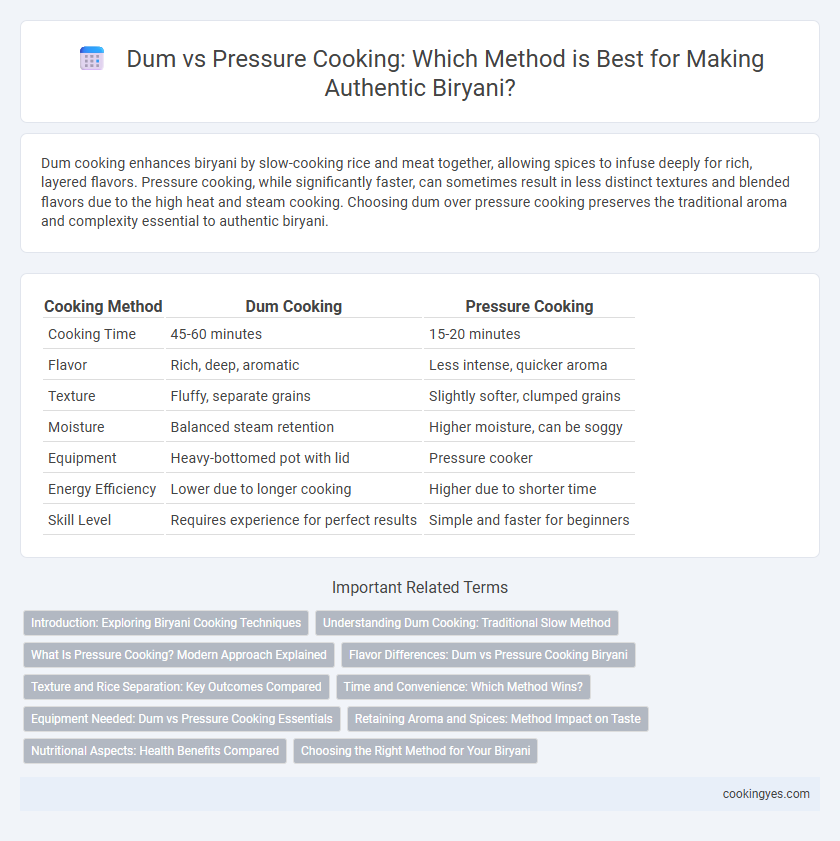Dum cooking enhances biryani by slow-cooking rice and meat together, allowing spices to infuse deeply for rich, layered flavors. Pressure cooking, while significantly faster, can sometimes result in less distinct textures and blended flavors due to the high heat and steam cooking. Choosing dum over pressure cooking preserves the traditional aroma and complexity essential to authentic biryani.
Table of Comparison
| Cooking Method | Dum Cooking | Pressure Cooking |
|---|---|---|
| Cooking Time | 45-60 minutes | 15-20 minutes |
| Flavor | Rich, deep, aromatic | Less intense, quicker aroma |
| Texture | Fluffy, separate grains | Slightly softer, clumped grains |
| Moisture | Balanced steam retention | Higher moisture, can be soggy |
| Equipment | Heavy-bottomed pot with lid | Pressure cooker |
| Energy Efficiency | Lower due to longer cooking | Higher due to shorter time |
| Skill Level | Requires experience for perfect results | Simple and faster for beginners |
Introduction: Exploring Biryani Cooking Techniques
Dum cooking preserves the rich aromas and layered flavors essential to authentic biryani by slow-cooking the rice and meat together in a sealed pot over low heat. Pressure cooking significantly reduces cooking time while tenderizing meat quickly, but may compromise the texture and depth of flavor characteristic of traditional dum biryani. Choosing between dum and pressure cooking methods depends on the desired balance between convenience and authentic taste in biryani preparation.
Understanding Dum Cooking: Traditional Slow Method
Dum cooking in biryani involves slow-cooking the rice and meat sealed tightly in a pot, allowing the steam to infuse flavors deeply and evenly. This traditional method preserves the aroma and texture, resulting in tender meat and fluffy rice with a rich, layered taste. The controlled low heat during dum cooking enhances the blending of spices, making it a favored technique for authentic biryani preparation.
What Is Pressure Cooking? Modern Approach Explained
Pressure cooking utilizes steam pressure to cook biryani faster by trapping steam inside a sealed pot, significantly reducing cooking time compared to traditional dum methods. This modern approach evenly cooks rice and meat by increasing the boiling point of water, ensuring flavors meld quickly without prolonged heat exposure. Pressure cooking is ideal for busy kitchens seeking to preserve biryani's rich spices and tender texture while saving time.
Flavor Differences: Dum vs Pressure Cooking Biryani
Dum cooking infuses biryani with rich, layered flavors by slow-cooking the rice and meat sealed in a pot, allowing aromas to meld and spices to intensify. Pressure cooking, while faster, often results in a less nuanced taste as high heat and steam can dilute delicate spices and reduce the depth of flavor. Choosing dum over pressure cooking enhances the traditional, complex fragrance and texture that defines authentic biryani.
Texture and Rice Separation: Key Outcomes Compared
Dum cooking preserves the delicate texture of each rice grain through slow steaming, resulting in fluffy, well-separated layers with enhanced aroma and flavor absorption. Pressure cooking tends to produce softer, sometimes mushy rice with less distinct grain separation due to rapid cooking under high pressure. For perfectly textured biryani with distinct, non-sticky rice, dum cooking remains the preferred method among culinary experts.
Time and Convenience: Which Method Wins?
Dum cooking for biryani, involving slow steaming over low heat, preserves intricate flavors and yields tender, perfectly cooked rice but requires 45 to 60 minutes. Pressure cooking significantly reduces preparation time to about 20-25 minutes, offering convenience for busy cooks but may compromise the layered texture and aroma found in traditional dum biryani. Choosing between time efficiency and authentic taste depends on whether speed or culinary quality is the priority in biryani preparation.
Equipment Needed: Dum vs Pressure Cooking Essentials
Dum cooking requires a heavy-bottomed pot or handi with a tight-fitting lid or dough seal to trap steam, ensuring slow and even cooking essential for biryani's layered flavors. Pressure cooking demands a sturdy pressure cooker equipped with a reliable gasket and whistle to maintain high pressure, significantly reducing cooking time while retaining moisture. Proper equipment selection directly influences texture and flavor development in biryani, making the choice between slow dum cooking and fast pressure cooking crucial.
Retaining Aroma and Spices: Method Impact on Taste
Dum cooking preserves the aroma and enhances the infusion of spices by slow-cooking biryani in a sealed pot, allowing flavors to meld naturally over time. Pressure cooking tends to accelerate the process but can cause some volatile aromatic compounds to dissipate, resulting in a less complex flavor profile. The traditional dum method ensures a richer taste experience through gradual heat and controlled moisture retention, crucial for authentic biryani.
Nutritional Aspects: Health Benefits Compared
Dum cooking preserves more nutrients in biryani due to its slow, low-heat process that retains vitamins and minerals, especially antioxidants from spices like turmeric and saffron. Pressure cooking, while faster, can cause some nutrient loss through high heat and steam pressure, potentially reducing the bioavailability of heat-sensitive vitamins such as vitamin C and certain B vitamins. Choosing dum cooking enhances the health benefits of biryani by maintaining its rich nutrient profile and preserving the delicate flavors of herbs and spices.
Choosing the Right Method for Your Biryani
Dum cooking preserves the rich flavors and aromatic steam essential to authentic biryani, producing tender, layered rice with infused spices. Pressure cooking offers a faster alternative, ideal for those seeking quick preparation, though it can sometimes compromise texture and subtle aroma. Selecting between dum and pressure cooking depends on your priority for flavor depth versus time efficiency in biryani preparation.
Dum vs Pressure Cooking for Biryani cooking method Infographic

 cookingyes.com
cookingyes.com